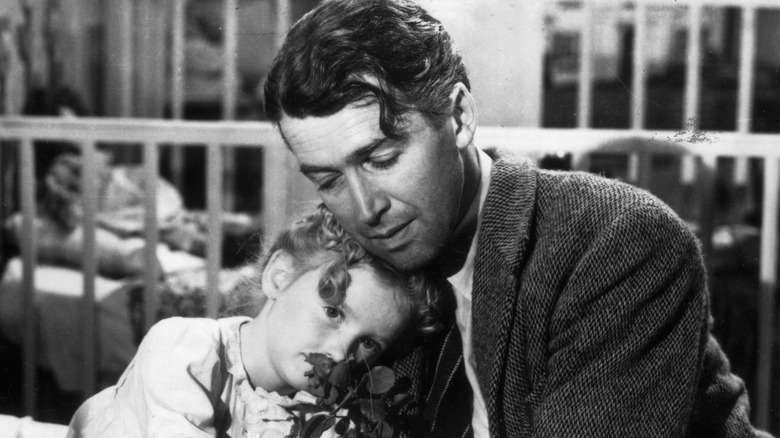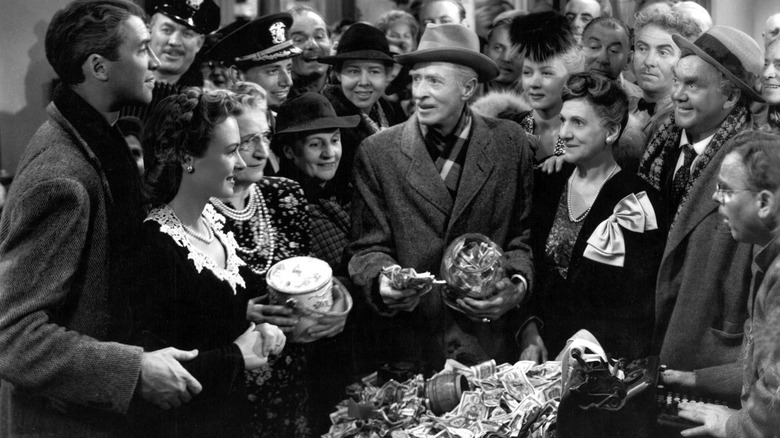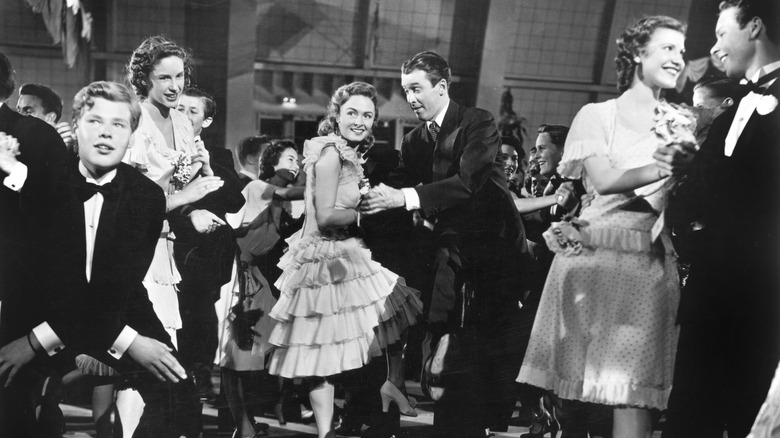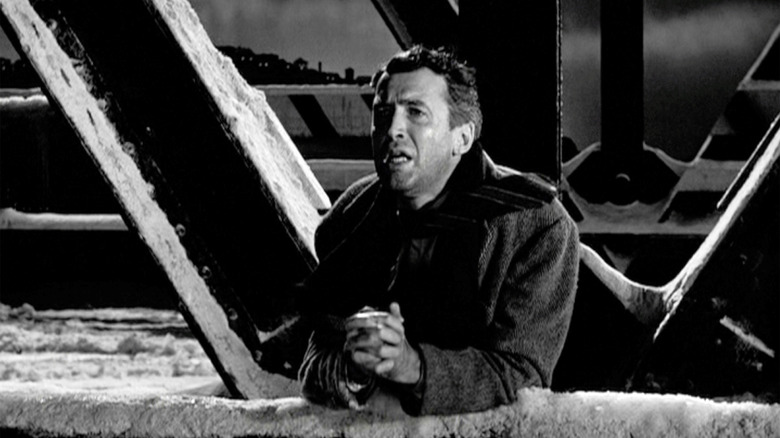Frank Capra Was 'Scared To Death' Going Into It's A Wonderful Life
"It's a Wonderful Life" is well-regarded in popular culture as a holiday classic, and its reputation as such typically conjures up an image of the hard-luck George Bailey (James Stewart) standing in front of a Christmas tree next to his wife (Donna Reed) and holding his daughter in his arms, his eyes filled with grateful, joyous tears.
Yet that image is, of course, from the finale of the film, and it's a well-earned emotional catharsis indeed when one considers the 129 prior minutes that led up to it. Watching the film brings with it an undeniable sense of desperation, as poor George tries throughout the course of his life to achieve his dreams and escape his hometown to no avail. When the angel second-class Clarence (Henry Travers) gives George the gift of proof that his life has actually made a difference, George is finally able to find happiness and peace, hence that climactic singalong of "Auld Lang Syne."
The pervading sense of unease and even fear within "It's a Wonderful Life" is no accident. Director and co-writer Frank Capra went about making the film while struggling with his own sense of fear, and thus the resulting movie is a fascinating encapsulation of existential anxiety.
Capra does unto others
Shortly after entering showbiz, Frank Capra made films on a regular, even prolific basis from the time of his first feature, 1926's "The Strong Man," to 1941's "Meet John Doe." The director found a great deal of success with a string of hits in the 1930s that included "It Happened One Night," "You Can't Take It With You," and "Mr. Smith Goes to Washington."
Yet 1941's "Meet John Doe" became his last feature film for a while, and by choice. That's because when America entered World War II, Capra insisted on enlisting, despite being 44 years old. As he recalled in his autobiography from 1971 entitled "The Name Above the Title," Capra explained his reasoning for joining the army: "I had a guilty conscience. In my films I had championed the cause of the gentle, the poor, the downtrodden. Yet I had begun to live like the Aga Khan."
Capra was subsequently given the task of making a series of Army-backed documentary features, and the result, "Why We Fight," increased Army morale while helping combat the disturbingly effective propaganda that was being produced by Nazi Germany.
Back from the war and uncertain
Upon the end of WWII in 1945, Capra decided to return to his Hollywood career, but found himself oddly at a loss as to how best to begin making films again. As Capra described his plight at an AFI lecture on "It's A Wonderful Life" in 1974:
"It was my first picture after being in the army for about five years. I was scared to death. I have not looked through the eyepiece of a camera at an actor in all that length of time. What would my first film be about? It certainly wasn't going to be about war. I had my belly full of war, and I came out a terrific pacifist. So what would it be about?"
As it turned out, in 1943 writer Philip Van Doren Stern had concocted an idea for a story about a man who decides not to commit suicide after a magical stranger shows him a world where he'd never been born. Calling it "The Greatest Gift," Stern self-published the short story in a pamphlet he sent to friends during Christmas.
Yet even when the head of RKO approached Capra with the idea, the filmmaker wasn't so easily satisfied. As he continued during that 1974 lecture:
"Three powerhouse guys had written scripts on this thing. They'd missed the idea ... In about nine paragraphs, there was the story. Man who was a failure was given the opportunity to come back and see the world as it would've been had he not been born, and he finds out that no man is a failure. Well my goodness, this thing hit me like a ton of bricks. So I wrote my own script, and that's the story of 'Wonderful Life.'"
'It's A Wonderful Life' allowed Capra to say what he wanted to say
Given Capra's newfound pacifism and distaste for war, "It's A Wonderful Life" is ironically not devoid of mentions of WWII, as a brief montage chronicling what the denizens of Bedford Falls were up to during the conflict occurs a little after halfway through the movie. Yet this sequence is telling not just in its relatively small amount of wartime stock footage, but in its place within the film. Just like most of America and Capra himself, George Bailey is left wondering after such a momentous historical event whether his life is all that significant, a spiritual crisis that's compounded after he finds himself (erroneously) holding the bag for misplacing the funds for his family Building & Loan.
George's journey into an alternate universe where he was never born allows him to experience firsthand the significance of his life, just as we the audience are experiencing how Capra unfolds the film in such a way to make moments and people that seemed minor before add up to a much larger significance. This is more than just Capra's design; it represents a reflection of what he discovered about his own work as he made the picture. As he explained:
"I think it represents for me what I've been trying to say in the others. But only I said it perhaps in a more novel form. I had never heard, or seen, this plot used, in which a man was allowed to see how his little world would've been had he not been born. This was, to me, novel, new, and a wonderfully humane way of pinning this idea down of the importance of the individual, which has always been the main theme of all my films."
In many ways, "It's A Wonderful Life" is a gift that keeps on giving, to those of us who love it as well as to those who made it.



